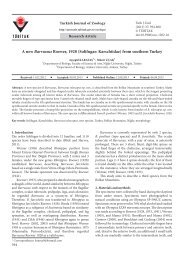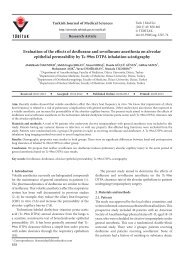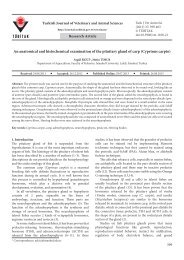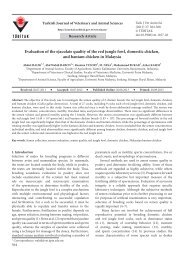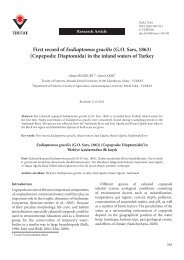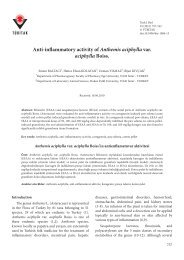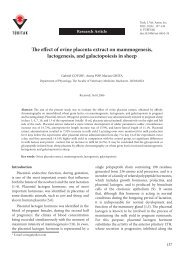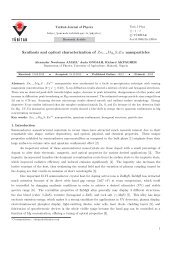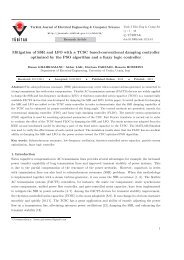Preliminary study on Acropora - Scientific Journals - Tübitak
Preliminary study on Acropora - Scientific Journals - Tübitak
Preliminary study on Acropora - Scientific Journals - Tübitak
You also want an ePaper? Increase the reach of your titles
YUMPU automatically turns print PDFs into web optimized ePapers that Google loves.
Figure 5. <strong>Acropora</strong> downingi: a) live col<strong>on</strong>y; b) porti<strong>on</strong> of col<strong>on</strong>y;<br />
c) porti<strong>on</strong> of branch, note different sizes of radial corallites; d)<br />
SEM micrograph showing coenosteum <strong>on</strong> a radial corallite<br />
proper; e) top view of axial corallite; f) SEM micrograph showing<br />
coenosteum between radial corallites.<br />
54°29′36.4″E; depth 9 m; 30 October 2009; MMTT Cnid.<br />
1377. Khark Island: 29°13′53.5″N, 50°17′53.5″E; depth 3<br />
m; 15 December 2009; ZUTC Cnid. 1503.<br />
Descripti<strong>on</strong>: Branching pattern: Arborescent,<br />
sometimes caespitose; col<strong>on</strong>ies mostly small, up to 35 cm<br />
in diameter (Figure 6a), seldom larger col<strong>on</strong>ies, up to 75<br />
cm in diameter; most branches upright, tapering slightly<br />
towards the tip and terete (Figures 6b and 6c); branch<br />
diameters: 5.5–14.0 mm, 5.3–13.5 mm, and 4.9–11.9 mm;<br />
branch length up to 47.0 mm; growth semideterminate.<br />
Axial corallites: C<strong>on</strong>spicuous, outer diameter 2.3–3.1<br />
mm; calice diameter 0.7–1.6 mm; at least 1 complete septal<br />
cycle present; primary septa maximum 3/4R; directive<br />
septa well developed; sec<strong>on</strong>dary usually absent, when<br />
present up to 1/4R (Figure 6f).<br />
Radial corallites: Regular and sturdy; appressed tubular<br />
to nariform (Figure 6d), gradually changing from branch<br />
tip towards its base; calice mostly oblique, sometimes<br />
dimidiate; 2 sizes; profile length 1.2–5.4 mm; outer walls<br />
extended al<strong>on</strong>g the branches; a few subimmersed corallites<br />
scattered <strong>on</strong> branches; dense immersed corallites at the base<br />
RAHMANI and RAHIMIAN / Turk J Zool<br />
Figure 6. <strong>Acropora</strong> arabensis: a) live col<strong>on</strong>y, note the distinct<br />
white branch tips; b) porti<strong>on</strong> of the col<strong>on</strong>y; c) porti<strong>on</strong> of branch;<br />
d) SEM micrograph showing close up view of radial corallites;<br />
e) SEM micrograph showing broken costae ornamentati<strong>on</strong> <strong>on</strong><br />
radial corallite; f) top view of axial corallite; g) SEM micrograph<br />
showing coenosteum between radial corallites.<br />
and between branches; at the base of branches first cycle<br />
complete, maximum septal development 1/3R, directive<br />
septa prominent, sometimes touching, particularly<br />
towards the bottom of calice; near the branches tip primary<br />
cycle mostly incomplete, directive septa present maximum<br />
1/4R; sec<strong>on</strong>dary cycle usually absent (especially in radials<br />
near the branch tip) or very short.<br />
Coenosteum: Broken-costate <strong>on</strong> radial corallites<br />
(Figure 6e); reticulate with simple, dense, laterally flattened<br />
spinules between radials (Figure 6g).<br />
Color: Dark brown to pale brown <strong>on</strong> branches, pale or<br />
white <strong>on</strong> branch tips (Figure 6a).<br />
Remarks: In general, most col<strong>on</strong>ies of A. arabensis<br />
are arborescent in the <str<strong>on</strong>g>study</str<strong>on</strong>g> area, while those described<br />
in Wallace (1999) were caespitose to low arborescent. The<br />
branches were also relatively thinner and much shorter<br />
in our specimens. C<strong>on</strong>versely, axial corallites of the<br />
specimens found in these parts of the Persian Gulf were<br />
larger than those described by Wallace (1999). Differences<br />
were also observed in the coenosteum: while that of the<br />
specimens in the present <str<strong>on</strong>g>study</str<strong>on</strong>g> is broken-costate <strong>on</strong> the<br />
313



